Latest News
Lowry in the North East
Lowry had been a visitor to Berwick-on-Tweed for short breaks from 1933, although precise details vary. He was attracted to Berwick and at one point he considered buying a house there in 1947 as he 'got to know' some of the local people. However, an architect friend advised him that there were structural problems with the property and he didn’t proceed, although he continued to be a regular visitor to Berwick up until the summer of 1975. The house he was attracted to was known as 'The Lions' and later featured in a number of versions of 'An Island' that sustained his interest in dereliction. 'An Island is an old house long uninhabited, falling further and further into decay. I seem to have a strong leaning towards decaying houses in deteriorated areas.' The house is also a feature of The Lowry Trail in Berwick which opened in 2004.
During the war he found painting difficult under the circumstances but he became an obvious choice for a war artist’s commission. He produced two works as an official war artist and Lowry was also recruited as a Fire Warden. Following a suggestion from a friend he then moved to the Elms, 23 Stalybridge Road, Mottram-in-Longdendale and he disliked it from the start. When he arrived in 1948 the garden had been well maintained, but, through neglect had become a wilderness. There were over a dozen clocks in his home and each told a different time. He had a room as a ‘workroom’ and when working he enjoyed listening to the music of Bach, Bellini, Beethoven, Vivaldi and Haydn. Later in his career he found a replacement for the industrial scene by focusing on individual people, with varying characteristics, set against a white background.
He finally retired as an employee of the Pall Mall Company in 1952 at the age of 65 and the success and recognition he craved followed in many different forms. There were numerous TV documentaries during the 50s and 60s, many exhibitions, and several academic awards from universities in Manchester, Salford and Liverpool. Throughout his life Lowry enjoyed travelling to different parts of Britain and he drew and painted many of the places he visited. He never learned to drive, so he explored the country by train, taxi, or car driven by friends. South Wales was also a favourite however his relationship with the North East, was deeper and more lasting than any of the other areas. 'One day I was travelling south from Tyneside and I realised that this was what I had always been looking for.'
During the war Cornish was compelled to fire-watch in between working underground and trying to retain contact with the Settlement. Mining was a reserved occupation to ensure continuity of coal supplies for the nation and whenever possible he would try to draw people in everyday working situations, under and over ground. 1944 was a pivotal moment when Cornish met Sarah Bartley who lived at Trimdon Grange. Her father had been a miner and her grandfather was a founder member of the ‘Blackhall Colliery Band.’ Cornish had been rejected by the parents of a previous fiancé because 'he was a miner.' Overcoming prejudice was to become a continuing thread weaving through the fabric of his life at different times and in many circumstances.
As a member of the Settlement Sketching Club Cornish was able to borrow authoritative books about famous and influential artists. Men of talent, but limited resources, were thus able to access the outside world via the medium of print. Life at the Settlement also enabled other arts-related experiences for the young Cornish and in April 1944 he was privileged to arrange paintings at the Settlement for a national touring exhibition organised by the Council for the Encouragement of Music and the Arts, which was a forerunner of the Arts Council. The exhibition included works by artists of the calibre of Vanessa Bell, Augustus John, Walter Sickert, Maurice de Vlaminck and Jacob Epstein. This experience was to become a significant factor in his invitation to be involved in the innovative 1947 exhibition 'Art by the Miner,' in London.
Cornish’s first one-man exhibition was at the ‘Green Room’ at the People’s Theatre in Newcastle and this was followed by the marriage of Norman and Sarah Cornish, and also the first awakening of national interest in his work as an artist. During their honeymoon visit to London Cornish visited the Reeves shop in Camden and discovered the Flo-master pen but he was unable to afford the drawing equipment which was later to become so important in his development as an artist. The fourteenth annual Sketching Club exhibition in November 1946 was to prove pivotal in the career of the young artist. G. Stevens, a London art exhibition organiser and professional artist, was quite taken by the quality of the work by Cornish. His visit to the Settlement was followed by another visitor, Dr R.W. Revans. He was Director of Education to the newly created National Coal Board and he bought five pictures for display in Hobart House, HQ of the Coal Board in London. One of the pictures is featured today and at the forthcoming exhibition at The Bowes Museum. 'The Big Meeting' 1947. In addition look out for ‘L.S. Lowry in Berwick and Northumberland’ The Granary Gallery, Berwick June 21st to September 21st 2024
The Sailors’ Bethel
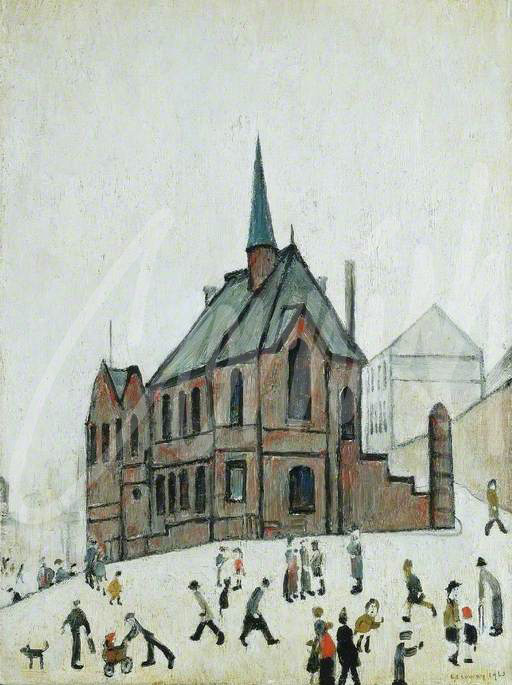
The Sailors’ Bethel opened in 1877 and can be seen at the Newcastle quayside. Bethel is Hebrew for ‘House of God’ and in the 130 years of its existence this building has served as a nonconformist chapel, a community centre, A Danish seamen’s church and more recently as offices.
In the late 19th century regular trade between Newcastle and Danish ports resulted in cargoes of butter, eggs, and fresh meat arriving at the mouth of the Ouseburn, and the Sailors’ Bethel was the ideal place for the Danish seamen to stay overnight whilst their cargo was unloaded.
During the 1960s the chapel became a subject of interest for both L.S. Lowry and Norman Cornish as contemporaries, exhibiting regularly at the Stone Gallery where Mick and Tilly Marsahll (owners of the gallery) acted as agents on behalf of both artists. Cornish used to visit the Stone Gallery at weekends and Lowry was a frequent visitor to the gallery although his accommodation was at the Seaburn Hotel near Sunderland. Both artists were active in and around Tyneside and the coast, deriving inspiration from people and places. Lowry painted his version of ‘Old Chapel’ in 1965 and the original is in the collection of the Laing Art Gallery. Lowry used his characteristic style, which he developed to suit the industrial and city subjects he generally painted, with a white background and limited palette of five colours: ivory black, vermillion, Prussian blue, yellow ochre and flake white.
Cornish first exhibited at the Laing Art Gallery in 1940 with his first portrait in oils, ‘My Sister Ella’. His version of the Sailors’ Bethel was only discovered in 2014 but was most likely produced during his journeys around Tyneside in the 60s.
Each version reflects the different styles and interpretation by both artists. With Cornish it is the rapid sketch capturing a moment in time using his Flo-master pen and watercolour added to the final version. With Lowry it was the attraction of the unusual architecture of the building. Similar subjects engaged both artists at different times in the Tyneside area, including All Saints church in Newcastle and the Groyne and Pier at South Shields.
According to Lowry, he generally invented the figures in his pictures. Cornish’s sketchbooks contain dozens of observations of people in different settings who often appear at a later stage in his paintings. 30 of Cornish’s drawings and paintings, inspired by locations in Newcastle and the pier at South Shields, feature significantly in Behind The Scenes: The Norman Cornish Sketchbooks which may be purchased at www.normancornish.com
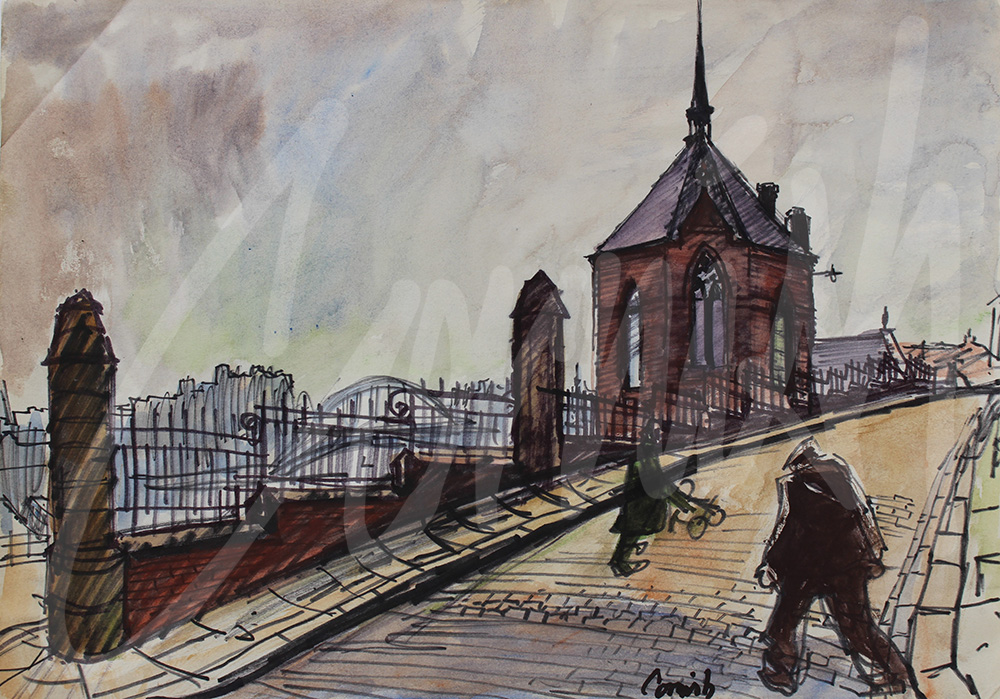
The Stone Gallery Years
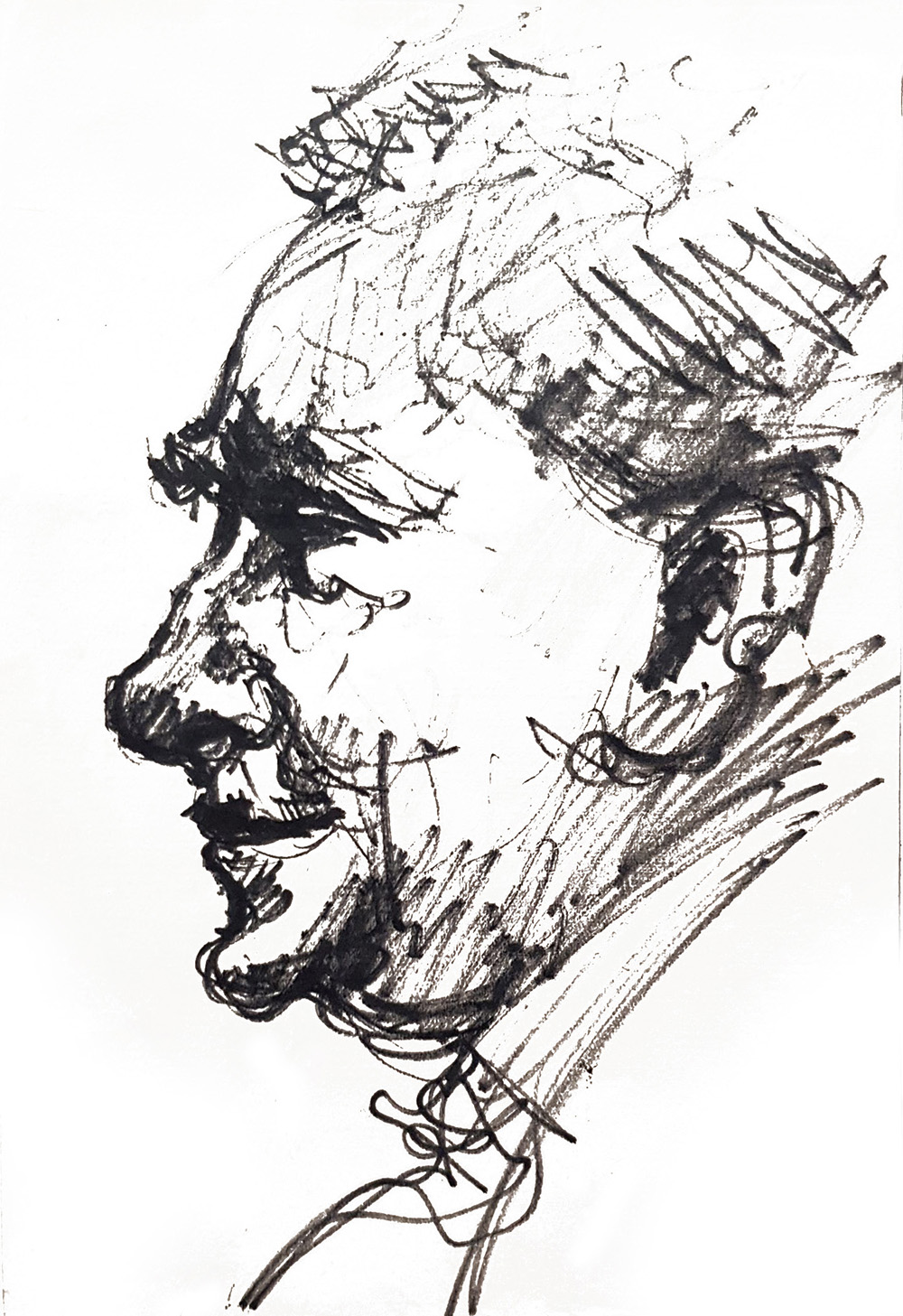
Cornish always said how important it was to be associated with a reputable gallery to promote an artist’s work and in 1959 he began a relationship with The Stone Gallery, Brunswick Place, Newcastle upon Tyne which was to last for 21 years.
Prior to this significant step his early work had been shown in the Spennymoor Settlement Sketching Club annual exhibitions from 1935. His first oil painting, which was a portrait of his sister Ella, appeared at The Laing Art Gallery in 1940 and thereafter he exhibited regularly in the northern region including Tullie House in Carlisle, The Shipley Gallery in Gateshead and in London on three occasions in 1950,1952 and 1956. Such was the culture of the era that exhibitions in public galleries was the dominant means of exposure to the public.
The owners of the Stone Gallery, Mick and Tilly Marshall, were to play a significant role in not only enabling solo exhibitions, but also acting as his agents to manage enquiries and promote his work going forward. Their gallery re-located to St Mary’s Place in Newcastle (near the Civic Centre) in 1962 to begin to build a reputation as the leading private gallery in the region and beyond. Aspiring artists acquire status by exhibiting (hanging) alongside those with established reputations and the following examples of mixed exhibitions at the Stone Gallery illustrate this point with details from the archive catalogues revealing who Cornish was hanging alongside.
1959/60: including John Piper, Joseph Herman, Tom McGuinness, John Peace.
1966: Painters of the North including Sheila Fell, LS Lowry, Theodore Major.
1966/67: including Jacob Epstein, Sir William McTaggart, LS Lowry, John Piper, Augustus John, WR Sickert.JM Whistler, George Roualt, Maurice de Vlaminck.
1967: including G. Romney, J. Constable, William Etty, W.Holman Hunt, D.G. Rossetti, Sir E. Burne Jones, Sheila Fell, LS Lowry, Sir William McTaggart, Ben Nicholson.
The solo exhibitions were also very successful and the mixed exhibitions attracted many visitors in the days prior to exposure on TV and before the internet. Without a telephone, contact from his agent was by post and a recurring theme from the many letters in the archive was the pressure he was under to take the big step from being a miner to becoming a professional artist which eventually happened in 1966.The Marshall’s also acted as agents for Lowry who was to purchase two of Cornish’s paintings. Another prominent collector was Prime Minister Ted Heath who also purchased two works by Cornish, one of which was a classic Man at Bar. During one visit to the Stone Gallery by Ted Heath, Cornish declined a group photo opportunity by Brian Forbes (film producer) which would have included Sheila Fell and LS Lowry.
Images: The Stone Gallery LS Lowry Sir William McTaggart President The Royal Scottish Academy sketch by Norman Cornish 1960
Cornish was delighted his work would hang in number 10, but equally nervous to appear in a newspaper alongside the PM!
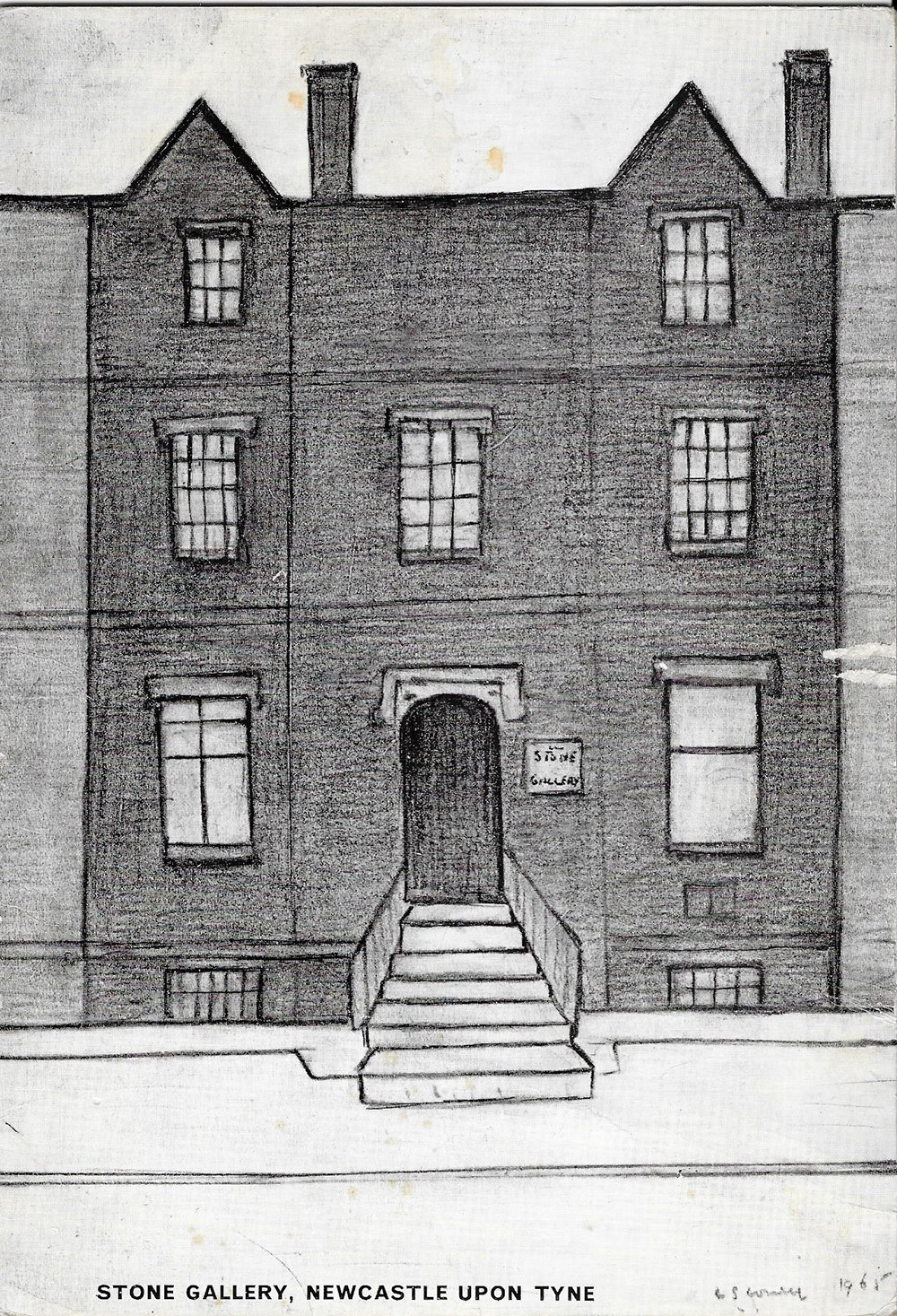
A New Era
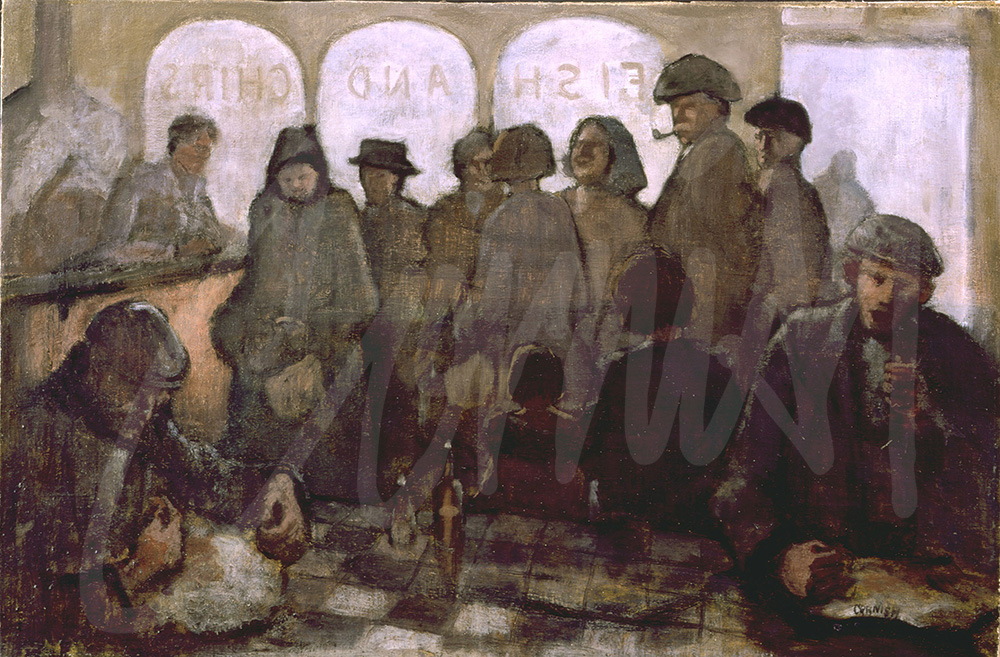
In 1945 at the age of 26 Cornish made an important aspirational statement published in the newsletter of a national organisation.
’Art this study that gives us so much pleasure, is worthy of study and personally I consider it worthy of the study of my whole lifetime.’
Despite having to continue working underground as a miner he began to make progress along the path to public exposure of his work, but also a growing recognition through sheer determination and resilience. These steps took him beyond the ‘Sketching Club’ exhibitions along a trajectory as a participant in exhibitions of huge significance in his development as an emerging artist of extraordinary ability. His first solo exhibition in 1946 at the Green Room, the People’s Theatre, Newcastle, was followed in London with ‘Art by the Miner’1947, including a first BBC TV appearance. In 1950 ‘The Coal Miners’ exhibition at the Artists International Association Gallery in Leicester Square continued the upward spiral of engagement and wider recognition.
More exhibitions were to follow and one of particular prominence in the north of England was planned in 1951 at Tullie House, Carlisle: ‘Realism in Contemporary Painting,’ by Northern Artists. The exhibition was organised by Cumbrian artist Norman Alford supported by Bob Forrester. Together they went to extraordinary lengths to highlight music and art in Cumbria with which the ‘ordinary man’ could engage. The underlying principle in the selection of artists and their work was that they should portray everyday life from their own specific locality: Social Realism. The other invited artists included; L.S. Lowry ‘The Punch and Judy Show,’ Norman Cornish ‘The Fish Shop,’ along with works by Ned Owens and Theodore Major.
Victor Pasmore, Head of Art at Newcastle University was a guest artist who wrote the catalogue introduction despite his modernist style which later proved controversial with his Apollo Pavillion structure in Peterlee in County Durham. During this post-war era other artists and art schools were creating a tension as they steered students towards ‘fashionable tricks’ and experimentation. One of Cornish’s contemporaries in the late ’50s and early ’60s disclosed that he had been ostracized at Leeds College of Art by tutors who were keen to embrace the modern art movement despite his love of a traditional approach to landscape and portraiture.
The Tullie House exhibition marked the beginning of a period of 16 years where Cornish and Lowry exhibited together, continuing in 1952, ‘The Mirror and The Square,’ New Barrington Galleries, London, and thereafter at The Stone Gallery in Newcastle where they shared the same agent. Cornish also returned on several occasions to The Borders Arts Society in Carlisle, during the mid- 60s to address the members about his work. The paintings of the original artists who exhibited in ‘Realism in Contemporary Painting’ have also stood the test of time and may be viewed via a simple search of the internet.
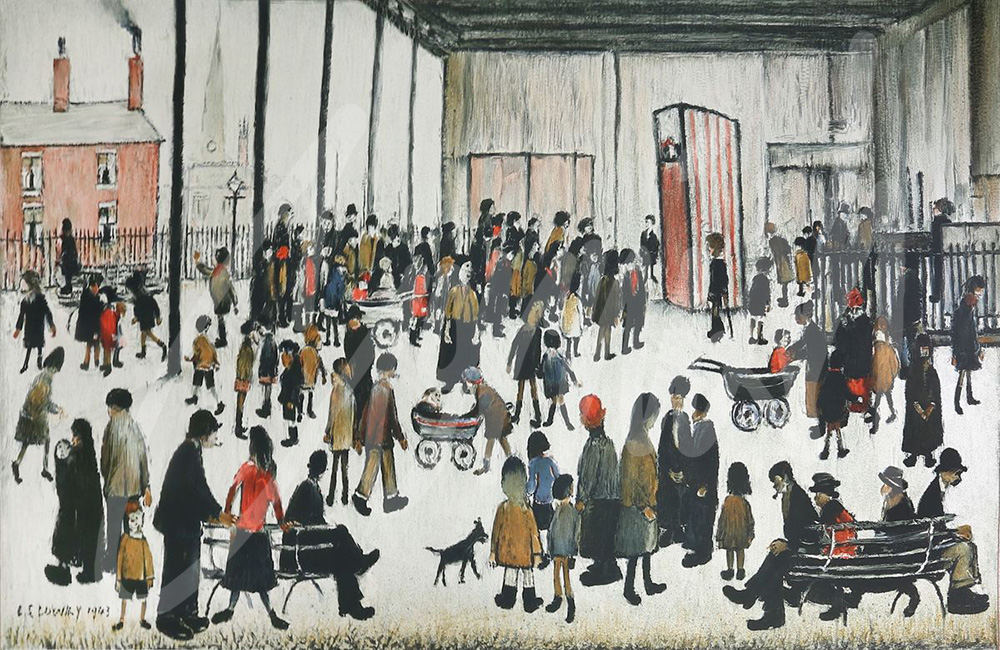
Mr Cornish and Mr Lowry: Together Again
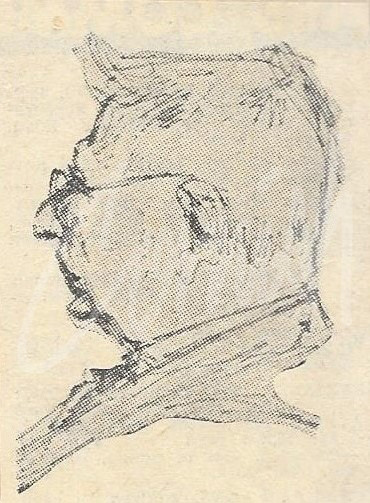
L.S. Lowry painted scenes of life in industrial districts of N.W. England, urban landscapes, seascapes, portraits and also surreal imaginings. He was a rent collector for 42 years, painting in his spare time. He became one of the most famous British Artists of the 20th Century and in 1976 he died six months before a major retrospective at The Royal Academy which attracted record numbers of visitors.
Norman Cornish 1919-2014 was perhaps the most famous artist to emerge from the North East of England in the 20th Century and he became one of the most famous artists of his time. His work is held in public and private collections throughout the UK and abroad. During his Centenary Year over 80,000 visitors enjoyed a range of exhibitions in the region including record numbers at The Bowes Museum retrospective.
Lowry was an outsider looking in on his subjects but Cornish was immersed in his community and accepted as a miner and artist for 33 years, prior to becoming a professional artist from 1966.
Between 1951 and 1967 Cornish and Lowry exhibited together on six occasions and were significant contemporaries during the ‘50s and ‘60s via their association with The Stone Gallery in Newcastle.
There is so much to say about both artists and too much for a single feature. An exhibition sounds like a good idea and here’s a date for your diary at:
The Bowes Museum 20th July 2024 to 19th January 2025
‘Kith and Kinship: Cornish and Lowry’
Together again
To be continued ………
Image: A drawing (Flo-master pen) by Norman Cornish of L.S. Lowry at The Stone Gallery, Newcastle, on October 30th 1964.
If you know who owns this rare drawing we would love to hear from you !
More Articles...
- Norman Cornish, Spike Milligan and Henri de Toulouse-Lautrec.
- The Durham Book Festival
- ‘The Test of Time:’ A new book about the life and work of Norman Cornish
- The Test of Time
- Hanging on the Walls
- Community Arts: Inspired by Norman Cornish
- Vincent van Gogh
- Norman Cornish 1973-2013 Academic success and national acclaim
- Parents: Jack and Florence
- The Port of Tyne Commission Part 1: Roll-On Roll-Off


